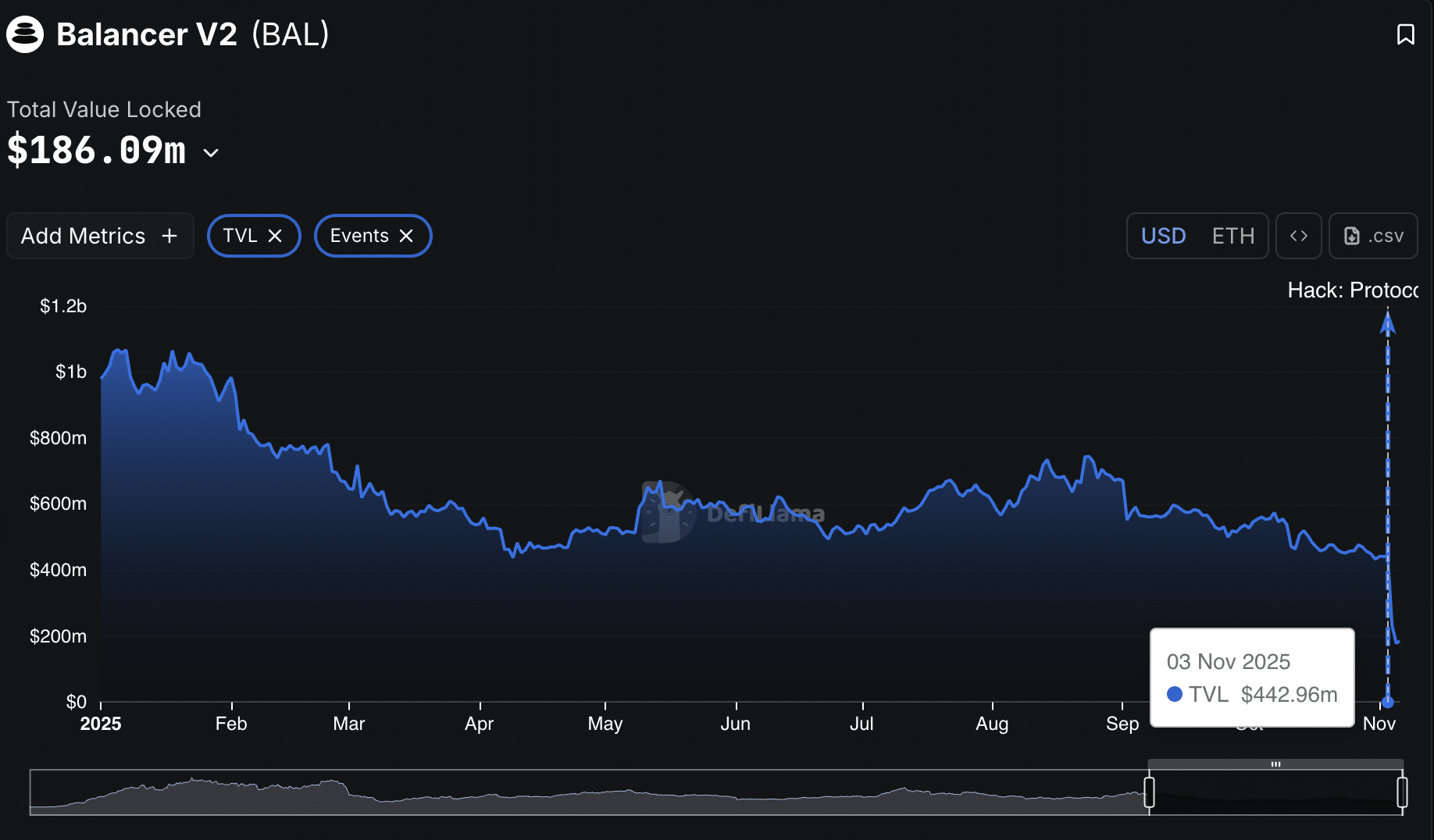The Balancer exploit in 2025 involved a rounding error in V2 Composable Stable Pools, allowing attackers to drain $128 million across seven blockchains via manipulated batch swaps. Recovery efforts have reclaimed $33 million, but TVL dropped 58% to $186 million, marking a significant blow to DeFi security.
-
Attack Scope: Ethereum saw the largest hit at $99 million, with additional drains from Base, Polygon, Arbitrum, Optimism, Sonic, and Avalanche.
-
Balancer’s quick response paused vulnerable pools, limiting further damage while V3 pools remained secure.
-
Post-exploit TVL fell from $443 million to $186 million, contributing to over $2.2 billion in 2025 DeFi losses so far.
Discover the Balancer exploit 2025 details: $128M hack via rounding error, TVL crash, and recovery updates. Stay informed on DeFi risks and safeguards—essential reading for crypto investors.
What is the Balancer Exploit in 2025?
The Balancer exploit in 2025 was a major security breach targeting the decentralized finance protocol’s V2 Composable Stable Pools, resulting in the theft of approximately $128 million on November 3. A critical rounding error enabled attackers to manipulate batch swaps, distorting liquidity balances and allowing unauthorized extractions across multiple networks. Balancer’s team swiftly paused affected pools, preventing escalation, though the incident highlighted ongoing vulnerabilities in DeFi infrastructure.
How did the Rounding Error Lead to the Balancer Hack?
The vulnerability stemmed from a precise rounding error in the mathematical calculations of V2 Composable Stable Pools, which Balancer detailed in its preliminary report released on November 5. This flaw permitted attackers to execute a series of batch swaps that artificially inflated and deflated token values, enabling them to withdraw far more funds than deposited. According to data from blockchain analytics firms like DefiLlama, the attack impacted seven chains, with Ethereum bearing the brunt at $99 million in losses. Experts, including DeFi security researcher Ariel Weisberg, noted that such arithmetic issues are rare but devastating in high-stakes environments, emphasizing the need for rigorous pre-launch audits. The protocol’s response time was under 10 minutes, freezing operations and safeguarding the majority of assets, as confirmed by on-chain transaction records.
Frequently Asked Questions
What Recovery Measures Are in Place After the Balancer Exploit?
Following the Balancer exploit, white-hat hackers and partner protocols like Berachain and StakeWise have recovered $33 million of the stolen funds. Berachain implemented a hard fork to retrieve $12.8 million and initiated user reimbursements, while StakeWise reclaimed $20 million through coordinated efforts. Balancer is preparing detailed recovery protocols for V2 pool users in an upcoming post-mortem report.
Has the Balancer Hack Affected All Versions of the Protocol?
No, the Balancer exploit targeted only V2 Composable Stable Pools, leaving V3 pools entirely unaffected and operational. This distinction underscores the robustness of Balancer’s newer architecture, which employs advanced safeguards against similar manipulation tactics. Users interacting with V3 reported no disruptions, maintaining normal liquidity provision and swaps during the incident.
Key Takeaways
- Exploit Mechanics: A rounding error in batch swaps drained $128 million across seven blockchains, with Ethereum losing $99 million.
- TVL Impact: Balancer’s total value locked plummeted 58% from $443 million to $186 million, exacerbating 2025’s DeFi losses beyond $2.2 billion.
- Recovery and Resilience: $33 million recovered so far; migrate to V3 pools for enhanced security and monitor official updates to avoid scams.
Conclusion
The Balancer exploit in 2025 serves as a stark reminder of the intricate risks in DeFi, where a subtle rounding error in V2 pools led to $128 million in losses and a 58% TVL decline. As recovery efforts continue with $33 million already reclaimed and V3’s integrity proven intact, the protocol is bolstering audits and migration paths. Investors should prioritize secure platforms and stay vigilant—Balancer’s path forward could redefine DeFi resilience in the coming months.
Key Takeaways
What caused the Balancer exploit?
A rounding error in V2 Composable Stable Pools allowed attackers to manipulate batch swaps and drain $128 million across seven blockchains,
How much did Balancer’s TVL drop after the hack?
TVL crashed 58% from $443 million to $186 million, resulting in a total loss of $257 million.
Balancer released its preliminary exploit report on 5 November, confirming that a rounding error in V2 Composable Stable Pools enabled the $128 million hack that struck 3 November.
The technical vulnerability allowed attackers to manipulate batch swaps and drain liquidity across seven blockchains.
Recovery efforts underway
White-hat teams recovered $33 million so far. Berachain executed a hard fork and clawed back $12.8 million, already beginning user repayments.
StakeWise reclaimed $20 million through its own recovery operations.
Balancer praised the “speed that stopped a bigger bleed,” noting the team contained the attack and protected most of the platform.
A comprehensive post-mortem report is forthcoming, including detailed recovery steps for affected V2 pool users.
The Balancer attack breakdown
Attackers hit Ethereum hardest, siphoning $99 million from the network. They also exploited pools on Base, Polygon, Arbitrum, Optimism, Sonic, and Avalanche, using batch swap manipulation to distort pool balances and extract value.
Balancer paused vulnerable pools within minutes of detection and froze additional damage. V3 pools stayed completely untouched throughout the attack, validating the protocol’s newer infrastructure.
The exploit ranks as 2025’s second-largest DeFi hack, pushing yearly losses across the ecosystem past $2.2 billion.
TVL devastation exceeds hack damage
The real story emerged in the TVL data. Balancer’s Total Value Locked collapsed from $442.96 million on 3 November to just $186.09 million today—a brutal 58% drop in two days.

Source: DefiLlama
The TVL chart shows a dramatic cliff dive marking the exploit, erasing months of relative stability around $450-600 million. Balancer had already declined from over $1 billion in January 2025, and the hack accelerated the downward trend.
Market and migration response
The BAL token dipped 6% following the exploit but stabilized as traders recognized V3’s resilience. The token held better than TVL, suggesting market confidence in Balancer’s ability to recover through migration.
Balancer now promotes aggressive V3 migration and warns users against scam messages that exploit the situation.
The team committed to code upgrades and deeper audits to prevent similar vulnerabilities.
